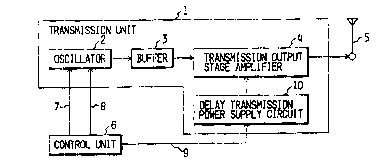Une partie des informations de ce site Web a été fournie par des sources externes. Le gouvernement du Canada n'assume aucune responsabilité concernant la précision, l'actualité ou la fiabilité des informations fournies par les sources externes. Les utilisateurs qui désirent employer cette information devraient consulter directement la source des informations. Le contenu fourni par les sources externes n'est pas assujetti aux exigences sur les langues officielles, la protection des renseignements personnels et l'accessibilité.
L'apparition de différences dans le texte et l'image des Revendications et de l'Abrégé dépend du moment auquel le document est publié. Les textes des Revendications et de l'Abrégé sont affichés :
| (12) Demande de brevet: | (11) CA 2003831 |
|---|---|
| (54) Titre français: | APPAREIL DE COMMUNICATION RADIO |
| (54) Titre anglais: | RADIO COMMUNICATION APPARATUS |
| Statut: | Réputée abandonnée et au-delà du délai pour le rétablissement - en attente de la réponse à l’avis de communication rejetée |
| (51) Classification internationale des brevets (CIB): |
|
|---|---|
| (72) Inventeurs : |
|
| (73) Titulaires : |
|
| (71) Demandeurs : | |
| (74) Agent: | BORDEN LADNER GERVAIS LLP |
| (74) Co-agent: | |
| (45) Délivré: | |
| (22) Date de dépôt: | 1989-11-24 |
| (41) Mise à la disponibilité du public: | 1990-05-28 |
| Licence disponible: | S.O. |
| Cédé au domaine public: | S.O. |
| (25) Langue des documents déposés: | Anglais |
| Traité de coopération en matière de brevets (PCT): | Non |
|---|
| (30) Données de priorité de la demande: | ||||||
|---|---|---|---|---|---|---|
|
ABSTRACT
The invention provides a radio communication apparatus, which includes
means for preventing unwanted and unnecessary radiation at the start of a
radio transmission. The apparatus of the present invention has a simple delay
circuit for slowly increasing the voltage applied to an amplifier in a
transmission unit including an oscillator, which generates a high-frequency
signal of a desired carrier, a buffer, and the amplifier to which is input the
high-frequency signal from the oscillator via the buffer and which amplifies
the signal and transmits data via an antenna. The delay circuit is connected
to a voltage line applied to the amplifier and slowly increases the voltage at
the start of the radio wave transmission. The input impedance of the
amplifier is prevented from sharply changing and is only allowed to change
slowly. The change of the input impedance of the amplifier is translated into
a change of load impedance of the oscillator, the amount of such impedance
change being decreased by the operation of the buffer. Thus, it is possible
to prevent the generation of unnecessary radiation at the start of the radio
wave transmission.
Note : Les revendications sont présentées dans la langue officielle dans laquelle elles ont été soumises.
Note : Les descriptions sont présentées dans la langue officielle dans laquelle elles ont été soumises.

2024-08-01 : Dans le cadre de la transition vers les Brevets de nouvelle génération (BNG), la base de données sur les brevets canadiens (BDBC) contient désormais un Historique d'événement plus détaillé, qui reproduit le Journal des événements de notre nouvelle solution interne.
Veuillez noter que les événements débutant par « Inactive : » se réfèrent à des événements qui ne sont plus utilisés dans notre nouvelle solution interne.
Pour une meilleure compréhension de l'état de la demande ou brevet qui figure sur cette page, la rubrique Mise en garde , et les descriptions de Brevet , Historique d'événement , Taxes périodiques et Historique des paiements devraient être consultées.
| Description | Date |
|---|---|
| Inactive : CIB expirée | 2015-01-01 |
| Inactive : CIB de MCD | 2006-03-11 |
| Inactive : Demande ad hoc documentée | 1996-11-25 |
| Inactive : Abandon.-RE+surtaxe impayées-Corr envoyée | 1996-11-25 |
| Demande non rétablie avant l'échéance | 1992-05-24 |
| Le délai pour l'annulation est expiré | 1992-05-24 |
| Inactive : Demande ad hoc documentée | 1991-11-25 |
| Réputée abandonnée - omission de répondre à un avis sur les taxes pour le maintien en état | 1991-11-25 |
| Demande publiée (accessible au public) | 1990-05-28 |
| Date d'abandonnement | Raison | Date de rétablissement |
|---|---|---|
| 1991-11-25 |
Les titulaires actuels et antérieures au dossier sont affichés en ordre alphabétique.
| Titulaires actuels au dossier |
|---|
| YOSHIYUKI YONEI |
| YOSHIYUKI YONEI |
| Titulaires antérieures au dossier |
|---|
| S.O. |